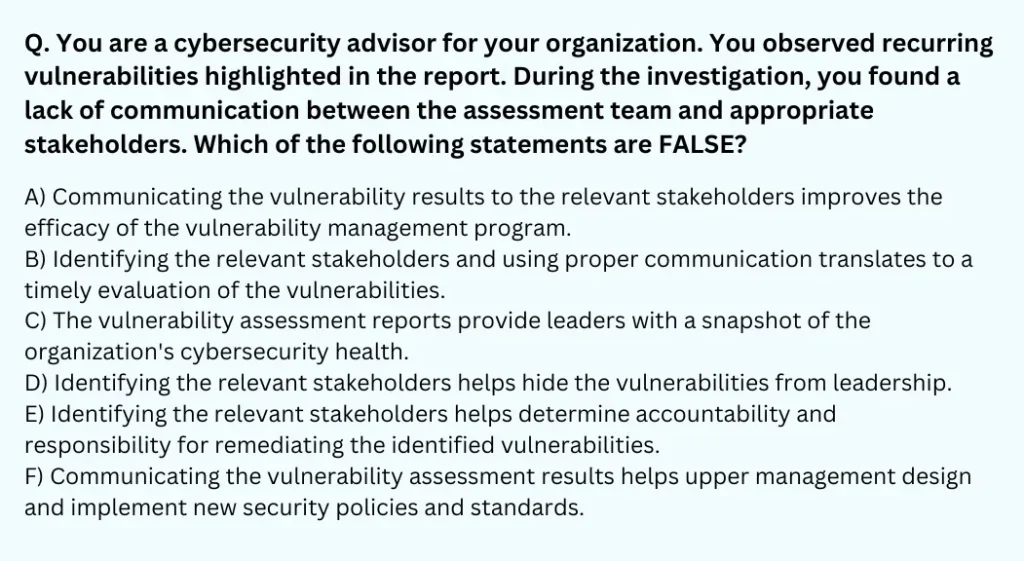Homework Help: Questions and Answers: You are a cybersecurity advisor for your organization. You observed recurring vulnerabilities highlighted in the report. During the investigation, you found a lack of communication between the assessment team and appropriate stakeholders. Which of the following statements are FALSE?

A) Communicating the vulnerability results to the relevant stakeholders improves the efficacy of the vulnerability management program.
B) Identifying the relevant stakeholders and using proper communication translates to a timely evaluation of the vulnerabilities.
C) The vulnerability assessment reports provide leaders with a snapshot of the organization’s cybersecurity health.
D) Identifying the relevant stakeholders helps hide the vulnerabilities from leadership.
E) Identifying the relevant stakeholders helps determine accountability and responsibility for remediating the identified vulnerabilities.
F) Communicating the vulnerability assessment results helps upper management design and implement new security policies and standards.
Answer:
To answer this question, we need to analyze each of the provided statements and determine which one is FALSE.
Given Options: Step by Step Answering
a) Communicating the vulnerability results to the relevant stakeholders improves the efficacy of the vulnerability management program.
- This is TRUE because effective communication helps ensure vulnerabilities are addressed and resolved by the appropriate individuals, improving the program’s effectiveness.
b) Identifying the relevant stakeholders and using proper communication translates to a timely evaluation of the vulnerabilities.
- This is TRUE. When the right people are informed, they can take timely action to assess and remediate vulnerabilities.
c) The vulnerability assessment reports provide leaders with a snapshot of the organization’s cybersecurity health.
- This is TRUE. Vulnerability reports provide an overview of current security issues and help leadership understand the organization’s cybersecurity posture.
d) Identifying the relevant stakeholders helps hide the vulnerabilities from leadership.
- This is FALSE. The goal of identifying stakeholders is transparency and to ensure appropriate accountability, not to hide vulnerabilities from leadership.
e) Identifying the relevant stakeholders helps determine accountability and responsibility for remediating the identified vulnerabilities.
- This is TRUE. Proper identification of stakeholders ensures that those responsible for remediating vulnerabilities are held accountable.
f) Communicating the vulnerability assessment results helps upper management design and implement new security policies and standards.
- This is TRUE. By understanding the assessment results, management can make informed decisions to improve security policies and standards.
Final Answer:
Based on the above analysis, the FALSE statement is:
D) Identifying the relevant stakeholders helps hide the vulnerabilities from leadership.
The false statement is D. Identifying relevant stakeholders is meant to improve communication and transparency, not to hide vulnerabilities from leadership. This goes against the principles of effective vulnerability management and organizational security.
All other statements (A, B, C, E, and F) are true and align with best practices in cybersecurity and vulnerability management.
Learn More: Homework Help
Q. Which of the following are examples of security threats? Select all of the boxes that apply.
Q. Which of the following image file formats uses lossy file compression?